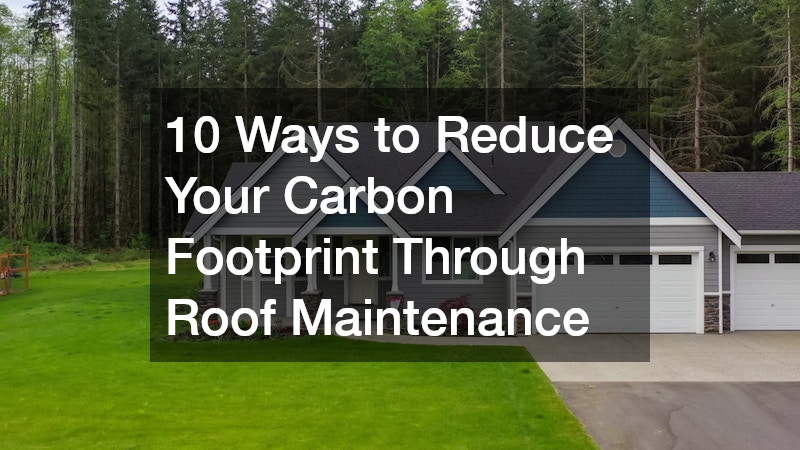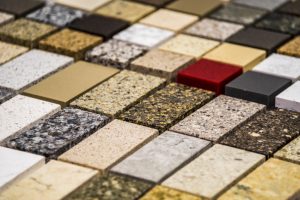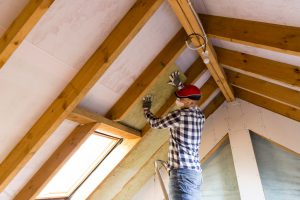Homeowners are increasingly aware of their environmental impact, and one of the most effective ways to contribute to sustainability is through careful attention to home maintenance. While many people focus on lifestyle changes such as reducing energy consumption or driving less, the home itself—particularly the roof—plays a significant role in energy efficiency and carbon reduction. The roof is more than a protective barrier; it influences heating and cooling, insulation performance, and even the efficiency of renewable energy systems such as solar panels. By maintaining and improving your roof, you can reduce unnecessary energy usage, prevent waste, and extend the life of the materials that protect your home.
Sustainability begins with a proactive mindset. Simple changes in how you care for your roof can translate to measurable environmental benefits, lower utility bills, and a more comfortable living environment. Beyond energy efficiency, a well-maintained roof also contributes to the aesthetic appeal and property value of a home, making it a smart long-term investment. By addressing both structural integrity and energy efficiency, homeowners can create a significant long-term impact on their carbon footprint. This guide will explore ten practical ways to maintain your roof while promoting energy efficiency and environmental responsibility.
- 1. Inspecting Roof Conditions Regularly
- 2. Repairing Leaks and Damages Promptly
- 3. Cleaning and Maintaining Gutters Efficiently
- 4. Upgrading Roof Materials for Longevity
- 5. Consulting Experts in Your Area
- 6. Enhancing Attic Insulation and Finishes
- 7. Updating Electrical Wiring Safely
- 8. Hiring Skilled Electricians for Efficiency
- 9. Working With Energy Efficiency Programs
- 10. Optimizing HVAC Systems for Sustainability
1. Inspecting Roof Conditions Regularly
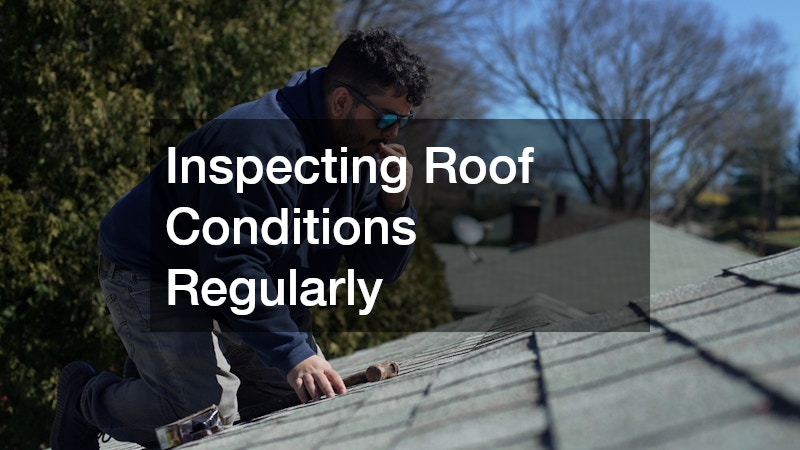
Regular inspections are a cornerstone of roof maintenance and energy efficiency. By routinely examining the roof for damage, wear, or deterioration, homeowners can identify small issues before they escalate into costly repairs. Inspections allow for timely interventions that preserve the roof’s protective function, prevent water intrusion, and improve the insulation’s effectiveness. Neglecting these checks can lead to leaks, heat loss, and structural problems that directly contribute to increased energy usage and carbon emissions. Seasonal changes, such as heavy rain or snow, can worsen unnoticed damage, making regular inspection even more crucial.
Engaging a qualified roofing contractor ensures that inspections are thorough and reliable. Contractors have the training and tools to detect subtle signs of damage, such as lifted shingles, minor cracks, or areas with compromised flashing. They can also provide recommendations on preventative measures, such as protective coatings or improved ventilation. By addressing issues promptly, homeowners not only extend the roof’s lifespan but also maintain optimal energy performance, which reduces unnecessary energy consumption and minimizes environmental impact. Regular professional inspections are an essential step in any sustainable home maintenance routine.
2. Repairing Leaks and Damages Promptly
Leaks and roof damages may seem minor initially, but they can have significant long-term consequences if left unaddressed. Water intrusion can compromise insulation, damage ceilings, and promote mold growth, all of which reduce the energy efficiency of a home. Prompt repairs maintain the roof’s structural integrity and thermal performance, preventing the need for excessive heating or cooling that would otherwise increase energy consumption. Even small cracks or missing shingles can worsen during storms, creating larger issues that require more materials and energy to repair.
Hiring a professional roofing service ensures that repairs are completed correctly and efficiently. These experts can identify the source of leaks, replace damaged materials, and reinforce areas prone to future damage. They also have access to high-quality, durable materials that can withstand environmental stressors for longer periods. Using these materials reduces the likelihood of frequent replacements, minimizing waste and energy use over time. Timely repairs keep the home well-insulated and energy-efficient, protecting both the property and the environment.
3. Cleaning and Maintaining Gutters Efficiently
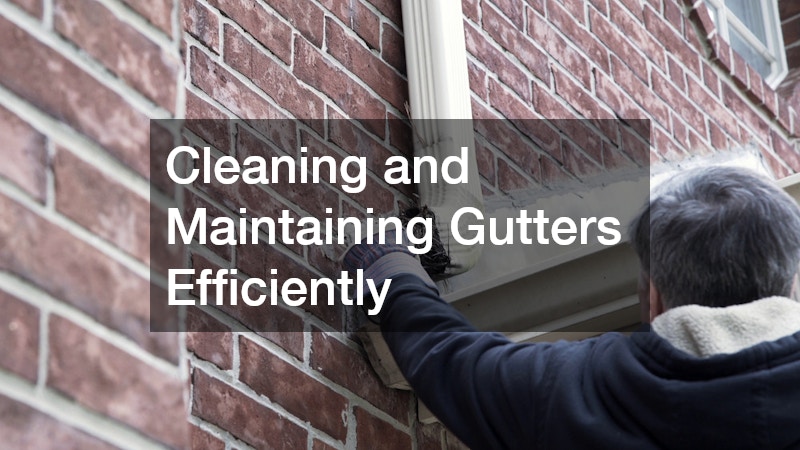
Gutters are often overlooked in roof maintenance, yet they play a crucial role in protecting the structure and conserving energy. Clogged or damaged gutters can lead to water pooling on the roof, which increases the risk of leaks, mold, and structural damage. These issues can compromise insulation and create uneven temperatures within the home, requiring more energy for heating and cooling. Routine gutter maintenance also prevents water from seeping into the foundation, which can indirectly affect indoor climate control and energy efficiency.
A professional roofing company can provide effective gutter cleaning and maintenance services. They ensure that debris is removed, downspouts are functioning properly, and water is directed away from the home. Some companies also recommend gutter guards or other protective measures to reduce debris accumulation over time. Efficient gutter maintenance prevents water-related damage that can affect insulation and energy efficiency, helping to create a home that is both sustainable and low-maintenance. Homeowners benefit from consistent performance and fewer unexpected repairs when working with professionals.
4. Upgrading Roof Materials for Longevity
The type of materials used on a roof directly impacts energy efficiency and environmental performance. Older roofs may use materials that degrade quickly or trap heat inefficiently, resulting in higher energy consumption for climate control. Upgrading to modern, energy-efficient materials enhances thermal performance, reflects sunlight, and reduces the need for heating and cooling. Materials such as metal roofing or reflective shingles can significantly reduce heat absorption, improving comfort and reducing energy use during warmer months.
Professional roof installation services are essential when upgrading materials. Experienced installers ensure that shingles, underlayment, and reflective coatings are applied correctly to maximize insulation and weatherproofing. Proper installation prevents gaps, leaks, or material misalignment that could undermine energy efficiency. Energy-efficient materials, such as cool roofing or recycled-content shingles, also contribute to environmental sustainability. By investing in a high-quality roof installation, homeowners reduce energy costs, protect the structure, and minimize their carbon footprint, creating long-term benefits for both the home and the environment.
5. Consulting Experts in Your Area

Local expertise is invaluable when maintaining a roof and improving energy efficiency. Different regions face unique weather patterns, humidity levels, and temperature variations that affect roofing performance. Consulting a local roofer ensures that maintenance and upgrades are tailored to regional conditions, increasing the effectiveness of insulation, ventilation, and protective measures. They may also be familiar with local building codes and energy efficiency incentives that can help homeowners make sustainable choices.
A local roofer can recommend region-specific practices for sustainability. For instance, in hot climates, reflective coatings or proper ventilation may reduce cooling demands, while in colder areas, additional insulation may prevent heat loss. These experts evaluate the roof’s orientation, pitch, and material compatibility to optimize energy efficiency. By leveraging local knowledge, homeowners achieve energy-efficient results that are practical, cost-effective, and environmentally responsible. Local guidance ensures that maintenance and upgrades have the greatest possible impact on sustainability.
6. Enhancing Attic Insulation and Finishes
The attic is a critical area for energy efficiency. Poorly insulated or unfinished attics can allow heat to escape in winter and enter in summer, forcing heating and cooling systems to work harder. Enhancing attic insulation and finishes creates a thermal barrier that stabilizes indoor temperatures, reduces energy use, and lowers greenhouse gas emissions. Additionally, a well-finished attic can prevent air leakage, moisture accumulation, and structural deterioration that could compromise roof performance.
Attic finishing professionals provide expertise in selecting and installing insulation materials that optimize energy efficiency. Techniques may include adding foam insulation, sealing air leaks, and finishing walls or floors to reduce energy loss. These improvements not only make the home more comfortable but also help HVAC systems operate more efficiently. Proper attic finishing ensures that the energy benefits of roof maintenance are fully realized, creating a sustainable living space that reduces overall carbon impact.
7. Updating Electrical Wiring Safely

Electrical systems in a home can influence energy efficiency, particularly when wiring is outdated or improperly installed. Inefficient wiring can lead to energy loss, overheating, and unnecessary strain on appliances and climate control systems. Updating wiring ensures that electricity flows efficiently, reducing wasted energy and lowering the home’s carbon footprint. Outdated wiring can also pose safety hazards that may require emergency repairs, which have environmental and economic costs.
A professional wiring service can assess the current electrical infrastructure and implement upgrades that improve efficiency. This may involve replacing old wiring, installing modern circuit breakers, or optimizing connections to heating, cooling, and lighting systems. By addressing inefficiencies, homeowners reduce electricity consumption and prevent energy loss. Well-maintained electrical systems work in tandem with roof improvements to create a more energy-efficient and safe home environment. Effective wiring is an essential, often overlooked, part of sustainable home management.
8. Hiring Skilled Electricians for Efficiency
In addition to wiring updates, skilled electricians provide essential services that promote energy conservation and overall home safety. They can install energy-efficient lighting, evaluate power distribution, and integrate systems that work seamlessly with modern HVAC or renewable energy technologies. Proper electrical work supports the home’s energy performance by ensuring that all systems function optimally in combination with roof insulation and attic ventilation. An inefficiently wired home can waste electricity, increase utility bills, and put unnecessary strain on appliances, which may also reduce their lifespan. By addressing these issues, homeowners contribute to a more sustainable and eco-friendly household.
A local electrician brings invaluable knowledge of regional building codes, energy programs, and home-specific requirements. They can recommend solutions that improve system efficiency and prevent energy loss, such as installing smart home technologies, optimizing circuit layouts, or introducing timed and programmable energy use systems. Smart thermostats and connected lighting systems allow energy to be used only when needed, reducing waste and lowering overall energy consumption. Working with qualified professionals ensures that electrical systems complement roof and attic improvements, creating a fully integrated approach to energy efficiency. By hiring a local electrician, homeowners can enjoy not only reduced energy bills but also improved comfort, safety, and a smaller carbon footprint.
9. Working With Energy Efficiency Programs
Energy efficiency programs offered through local utilities or government initiatives provide valuable resources for homeowners. These programs often include assessments, rebates, and guidance on reducing energy consumption in heating, cooling, and insulation systems. Collaborating with a local mass save contractor can identify opportunities to optimize roof performance and maximize energy savings. Participating in such programs also supports broader environmental goals by reducing overall energy demand.
A local mass save contractor evaluates the home’s energy profile, including roof condition, insulation, and HVAC performance. They can recommend cost-effective improvements such as enhanced insulation, reflective roofing materials, or energy-efficient upgrades that complement roof maintenance. Contractors also help homeowners navigate incentive programs that make sustainable choices more accessible. By working with these experts, homeowners benefit from structured guidance, measurable energy reductions, and reduced carbon emissions. Leveraging these programs aligns roof maintenance with larger sustainability objectives, creating a practical path toward a greener home.
10. Optimizing HVAC Systems for Sustainability
The efficiency of a home’s heating, ventilation, and air conditioning systems is closely linked to the condition of the roof. Poor insulation, leaks, or inadequate ventilation can force HVAC systems to work harder, consuming more energy and producing a larger carbon footprint. Optimizing HVAC performance ensures that energy use is minimized and the home remains comfortable throughout the year. Regular system checks can also extend the life of the equipment, reducing waste and replacement costs.
HVAC services provide professional evaluation and maintenance of climate control systems. Technicians can inspect ducts, improve airflow, clean components, and suggest upgrades that enhance efficiency. When combined with roof maintenance and attic improvements, these services reduce energy waste and lower utility bills. A well-functioning HVAC system works in harmony with the roof and insulation to create a more sustainable home environment. By optimizing heating and cooling efficiency, homeowners can make a meaningful contribution to reducing their overall environmental impact.
Reducing a home’s carbon footprint requires a holistic approach that addresses both energy use and structural efficiency. Roof maintenance is a central component of this effort, influencing insulation, climate control, and the longevity of building materials. By regularly inspecting the roof, addressing leaks, cleaning gutters, upgrading materials, and optimizing the attic and electrical systems, homeowners can significantly reduce energy consumption. Partnering with local experts ensures that improvements are both effective and appropriate for regional conditions, while participating in energy efficiency programs amplifies these benefits.
Sustainability is achieved not only through large-scale changes but also through consistent, informed maintenance practices. Thoughtful attention to the roof, attic, and energy systems supports long-term energy conservation, reduces waste, and minimizes the environmental impact of everyday living. By integrating these strategies into a regular home maintenance routine, homeowners create a comfortable, efficient, and environmentally responsible household. Roof maintenance is not just about protecting a home; it is a tangible way to reduce carbon emissions, preserve resources, and contribute to a more sustainable future for both current and future generations.

